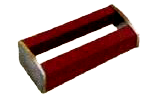State how magnetic susceptibility is different for the three types of magnetic materials, i.e., diamagnetic, paramagnetic and ferromagnetic materials.
To understand how magnetic susceptibility differs among diamagnetic, paramagnetic, and ferromagnetic materials, we can analyze each type of material based on their magnetic properties and the behavior of their susceptibility.
1. Definition of Magnetic Susceptibility:
- Magnetic susceptibility (χ) is defined as the ratio of the magnetization (M) of a material to the applied magnetic field intensity (H).
- Mathematically, it is expressed as:
χ=MH
- It is a dimensionless quantity that indicates how much a material will become magnetized in an external magnetic field.
2. Diamagnetic Materials:
- Diamagnetic materials are those that create an induced magnetic field in a direction opposite to that of the applied magnetic field.
- This results in a very weak repulsion from the magnetic field.
- The magnetic susceptibility (χ) for diamagnetic materials is:
χ<0
- This means that the susceptibility is small and negative.
3. Paramagnetic Materials:
- Paramagnetic materials have unpaired electrons that align with the external magnetic field, resulting in a weak attraction to the magnetic field.
- The magnetic susceptibility (χ) for paramagnetic materials is:
χ>0
- This indicates that the susceptibility is small and positive.
4. Ferromagnetic Materials:
- Ferromagnetic materials have a strong tendency to become magnetized in the direction of the applied magnetic field due to the alignment of their magnetic domains.
- The magnetic susceptibility (χ) for ferromagnetic materials is:
χ≫0
- This means that the susceptibility is very high and much greater than zero.
5. Summary of Differences:
- Diamagnetic: χ < 0 (small and negative)
- Paramagnetic: χ > 0 (small and positive)
- Ferromagnetic: χ >> 0 (very high and positive)
- Magnetic susceptibility (χ) is defined as the ratio of the magnetization (M) of a material to the applied magnetic field intensity (H).
- Mathematically, it is expressed as:
χ=MH
- It is a dimensionless quantity that indicates how much a material will become magnetized in an external magnetic field.
- Diamagnetic materials are those that create an induced magnetic field in a direction opposite to that of the applied magnetic field.
- This results in a very weak repulsion from the magnetic field.
- The magnetic susceptibility (χ) for diamagnetic materials is:
χ<0
- This means that the susceptibility is small and negative.
- Paramagnetic materials have unpaired electrons that align with the external magnetic field, resulting in a weak attraction to the magnetic field.
- The magnetic susceptibility (χ) for paramagnetic materials is:
χ>0
- This indicates that the susceptibility is small and positive.
- Ferromagnetic materials have a strong tendency to become magnetized in the direction of the applied magnetic field due to the alignment of their magnetic domains.
- The magnetic susceptibility (χ) for ferromagnetic materials is:
χ≫0
- This means that the susceptibility is very high and much greater than zero.
- Diamagnetic: χ < 0 (small and negative)
- Paramagnetic: χ > 0 (small and positive)
- Ferromagnetic: χ >> 0 (very high and positive)
Similar Questions
Ferromagnetic material and non-magnetic material
View SolutionAll metals are magnetic materials.
View Solution
Are keepers magnetic or non-magnetic materials?
View SolutionA diamagnetic material in a magnetic field moves
View SolutionA diamagnetic material in a magnetic field moves
View SolutionS is the surface of a lump of magnetic material.
View SolutionAll these magnetic materials loss their magnetic properties when
View SolutionA ferromagnetic material is placed in an external magnetic field. The magnetic domains
View SolutionMagnetic force can pass through non-magnetic materials.
View SolutionThe permeability of magnetic material is 0.9983. Name the type of magnetic materials it represents.
View Solution
